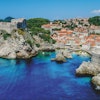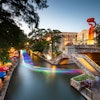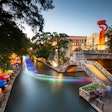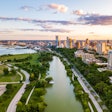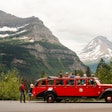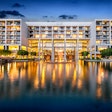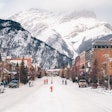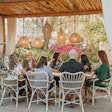When Visit Indy President and CEO Leonard Hoops compares Indianapolis to Paris, there’s not a speck of doubt in his voice.
Both cities are flat, landlocked, riverside and abundant in history. And while mountains and oceans do add visual appeal, they’re not required for a city to stand out. Hoops, who had previously worked at San Francisco Travel Association as chief customer officer for four years, credits Indy’s recognition as a conventions hub to the work of previous mayor and U.S. Senator Richard Lugar.
“As manufacturing was phasing out of Indianapolis, he laid out a path so that Indy would be the biggest event and convention destination in America,” says Hoops.
Flash forward 40 years and the downtown area alone spans 7,100 hotel rooms, 4,700 of which are connected and within a few minutes’ walk of the 749,000-sq.-ft. Indianapolis Convention Center.
A City With a Plan
When Visit Indy’s team pulled up all of the bids they’d made for the convention center from the last two years, they discovered that their top five competitors for a citywide now are Nashville, Chicago, Atlanta, Boston and Denver. That wasn’t their comp set 10 years ago.
“All of a sudden my friends in Chicago, Atlanta and Denver were struck, like ‘Wait, we’re bidding against Indy?’” Hoops remarked.
The city has experienced a number of turning points in the last 10 years from the debuts of the Indianapolis International Airport and Lucas Oil Stadium in 2008 to hosting the Super Bowl in 2012.
While new airports, stadiums and hosting a Super Bowl would trigger significant growth for any town; what makes Indianapolis one to watch is its commitment to a sustainable growth tourism model.
For the last four years, Visit Indy has been hard at work on a Tourism Master Plan. The plan lays out seven strategies that revolve around five guiding principles. After conducting interviews with stake holders, Visit Indy opened its ears to the general public and received over 2,500 responses. T
he item that resonated most was the development of White River Park, a 250-acre outdoor venue and greenway that runs along the 58-mile White River. And the results are already showing, the park recently hosted the opening ceremony of MPI’s 2018 World Education Congress.
In With the Old and In With the New
In Indianapolis, it’s not about what’s old or what’s new. Its amenities, respectively, date back as far as Slippery Noodle, a blues bar founded in 1850, to the Indianapolis Cultural Trail, an urban bike and pedestrian path connecting the six “cultural” neighborhoods that met its 8-mile completion in 2013.
Along the ICT, bikers and pedestrians can capture views of the city, participate in food tours and interact with art along the pathway.
The same goes for food. While there is an assortment of historic restaurants in Indy like St. Elmo’s Steak House, over the last five years, a wave of chefs have assembled a community of James Beard nominated restaurants like Milktooth and Bluebeard along Virginia Avenue.
And while major hotel brands do dominate the city, construction for one of the nation’s six West Elm hotels recently broke ground in an abandoned Coca-Cola plant. Catering to a more contemporary audience, the hotel will feature local art and a rooftop bar.
Designing Experiences
Since hosting PCMA in 2013, Indianapolis Convention Center has nearly doubled in size.
Making way for citywides can be an overwhelming process but finding ways to elevate individual parts of the experience is where senior Vice President of Visitor Experience Susie Townsend shines.
Townsend served on the 2012 Super Bowl local organizing committee, where she managed all of the VIP and guest experiences; has worked four Final Four tournaments; and hosted PCMA in 2004 and RCMA in 1998.
“My team helps plan all of our VIP and customer events and we’ve elevated that department to something beyond a VIP dinner at a restaurant—whether it’s here in Indy or another city,” she says.
By design, Indianapolis is a well-laid out city. Outlined by Alexander Ralston, prodigy to Pierre L’enfant who planned Washington D.C., Indianapolis follows a perfect grid.
The downtown area serves as a hub for major hotels, as laid out by Lugar during his term as mayor. Over 40 years, Indianapolis built one hotel after another, connected them, expanded the convention center, built Lucas Oil stadium and, by the end, was able to give planners and rights holders a one-stop shop for all of their needs.
“Every person who came after Lugar, whether Republican or Democrat, upheld that plan. Everyone in state legislature knows that that’s our DNA now,” says Hoops.
With mainstays like the beautifully restored Omni Severin, the city’s longest running luxury hotel, and major additions like the JW Marriott, Indianapolis’ downtown resembles a hotel ecosystem, rather than an arena for competition. Marriott recently bought back its Downtown Marriott property and executed a $45 million renovation to bring it up to bar with the JW Marriott and Courtyard Marriott.
“It’s about working together to make sure the city wins first, because then we know we’ll all win,” say Phil Ray, general manager of the JW Marriott Indianapolis.
On the Docket
- NBA All-Star Game in February 2021
- NCAA Men’s Final Four in April 2021
- Indy 500 (annual)
- Big 10 Divisional Championship (annual)
- College Football National Championship in January 2022
Property Profile: Omni Severin Hotel
Servicing visitors to Indianapolis for more than 100 years, the Omni Severin Hotel is the ideal place for visitors looking to absorb a piece of Indy’s history in their sleep. With more than 300 restaurants and shops nearby, the hotel is prime location to the City Centre Mall and is connected via skywalks to the Indianapolis Convention Center. Omni reaps recognition for its hospitality and service and the Severin is no exception. As soon as a guest walks in, they’re immediately greeted by a seamless valet service, friendly “hello” and a cup of chilled, fruit-infused water. The property features 424 newly renovated rooms and suites, an indoor heated pool and fitness center and Starbucks inside the hotel. Guests can enjoy fine dining at the 1913 Restaurant, a curated wine collection at The Wine Thief and their favorite live TV and sports events at Severin Bar.

